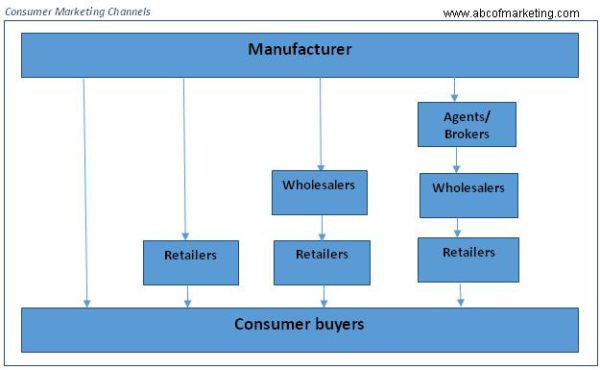Discuss Types of Marketing channels/ Channel Levels and Channel Flows.
 Email This Post
Email This Post
The producer and the end consumer are the starting and end point of the marketing channel. The presence of number of intermediaries depends on the marketing objectives of the organisation. Selecting the right channel is a critical task as it can be the reason for failure or success of the product. We will look at the Levels of marketing as shown in the figure above.
Manufacturer – Consumer channel, there is absence of intermediaries. Here the manufacturer opts to sell directly to the customer. Hence, this level is also known as Direct-marketing channel. The internet, television (cable networks) give great opportunity to manufacturers to reach their prospective customers. Manufacturers understand the power of retailers as the final link to the customers. To reduce this influence of retailers, organisations follow this channel. This channel structure is also economically viable as the manufacturer doesn’t needs to give sales or profit margins to intermediaries. Some examples of this channel are: mail order, door-to-door selling, internet selling, Television commercials (infomercials), telemarketing, and manufacturer store outlets.
Manufacturer – Retailer – Consumer channel has one intermediary. This intermediary is generally a retailer in consumer markets. For example, producers of televisions, appliances, etc. sell their products to large retailers who buy these products in bulk. These retailers have large distribution network. They break down the large bulk quantities into smaller ones and distribute to their stores in the market. For example, departmental stores, shopping malls, super markets, etc. The manufacturer performs the function of the wholesaler. There are many reason for adopting this channel- a) Sometimes, the product needs immediate distribution and cannot be stored for long (perishable products), b) more proximity to end consumers to study their response, c) shorter channel has better control.
Manufacturer – Wholesaler – Retailer – Consumer: Smaller retailers cannot buy in bulk from producers. Here the producers sell the bulk to wholesalers who break the bulk and sell it to retailers. For example, hardware, drugs, food items, etc.
Manufacturer – Agents/Brokers – Wholesalers – Retailers – Consumers: This three-levelchannel has three intermediary levels. When the manufacturers don’t have many clients they take benefits of agents/brokers. When manufacturers find it difficult to reach the wholesalers through their representatives or branches, they take help of agents or brokers on commission basis. Agents/brokers negotiate purchases or sales, or both, but do not take ownership of the goods. They are likely to have several contacts or clients in the market and can arrange variety of product. For example, imported goods, textile goods, agricultural goods, etc.
Marketing channels with more levels are also found in some organisations. But each intermediary in paid a margin for its service. This adds to the cost and price of the product. Also, more the number of intermediaries lesser is the manufacturers control on the channel.
In Business marketing channels, the manufacturer’s sometimes use their own sales people to sell to industrial buyers. The industrial distributors also help an organisation increase its market presence in industrial markets. They have large client base and their expertise helps an organisation expand its business. Depending on the scale of business, the organisation can directly sell through the industrial distributors, or its representatives and sales branch can sell to industrial buyers through industrial distributors.
Channel Flows –
Supply Chain Managementinvolves the management of materials, information, etc. from the suppliers to the physical distribution of the finished products to the consumers which encompasses logistics, material handling, and purchasing.
The entire management in Supply Chain from the source to the consumer and back involves forward flow as well as backward flow. Apart from flow of physical products, the other flows are information, ownership, money (financial transactions), and risk.
Physical flow starts from the source of the channel that is suppliers. This flow, mainly via transportation is among suppliers, manufacturers, intermediaries, and consumers. There may be backward flow of physical goods in case of returns for various reasons like defects, etc.
Title flow involves transfer of ownership through the channel. The flow of ownership accompanies physical flow most of the times but not all the intermediaries take title of the product. Brokers and agents negotiate deals but don’t take title of the product.
Payment flow or financial flow is movement of payment of goods within the channel. It may involve financial institutions like banks, finance firms, etc. Payment can be in cash or credit and it flows in the direction opposite to the flow of physical flow.
Information flow involves negotiation, terms of sale, advertising, etc. It is the flow of information within the channel among different intermediaries, consumers, manufacturers, and suppliers. It may be a feedback, an appreciation, a request, or even a complaint from the consumer, and a reply to this from the manufacturer, wholesaler or a retailer.
Risk flow involves all kinds of risks in handling the product. It usually flows with the flow of physical flow and affects all the members of the channel. Product becoming outdated, passing its expiry date, defects, price changes, etc. are many of the risks that affect the buyers and sellers. All the members on the channel try to reduce the risk by various means like insurance against damage, finance firms increase interest rates, etc.
(The above is partly based on discussions by “Prof. Philip Kotler”, and “David Cravens, Gerald Hills and Robert Woodruff”).

